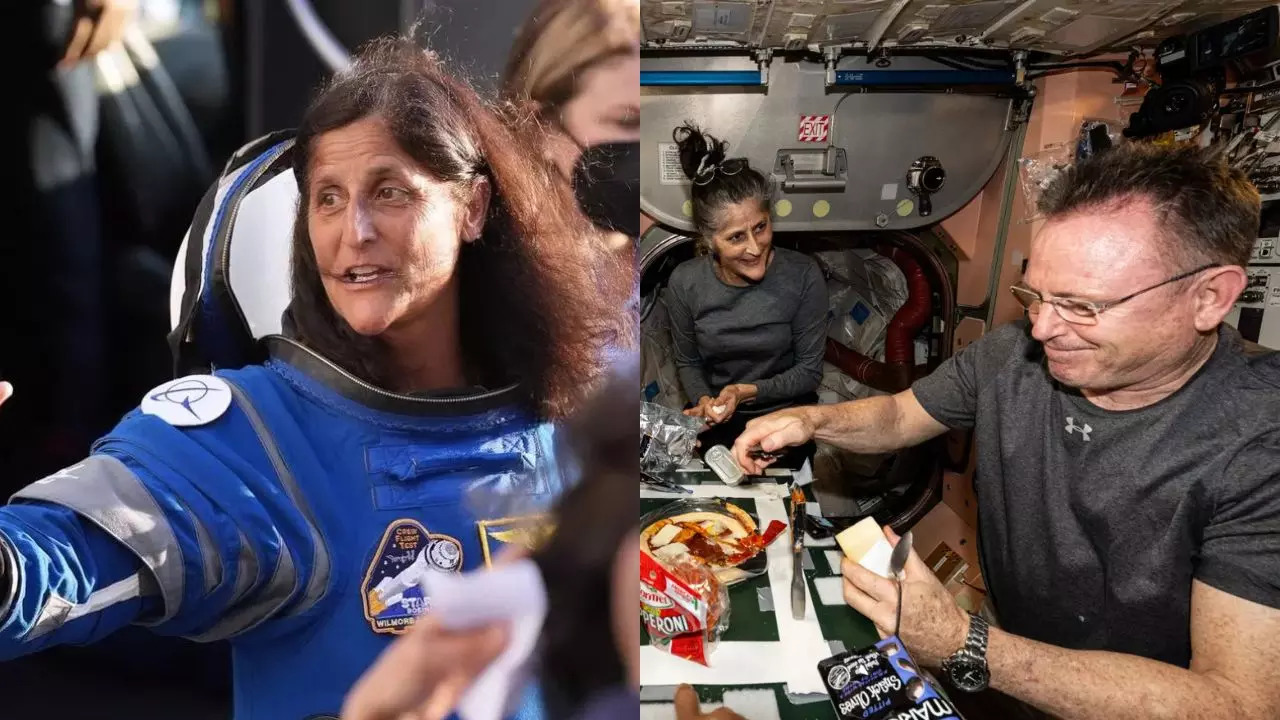
Astronaut Sunita Williams, 59, has had a massive weight loss during her 155-day mission at the International Space Station (ISS). Recently released photos on X (formerly Twitter) have sparked global concern, where she can be seen with sunken cheeks, and a skinny appearance. This shows that prolonged space travel has taken a toll on her body.
Her condition has become a serious point of NASA’s health monitoring efforts as they work towards her drastic weight loss and try to improve her overall well-being. Williams began her mission in June, initially weighing around 140 pounds (63 kgs), but living in space for long has led to major weight loss. According to NASA officials, the combination of high-calorie requirements and daily rigorous exercise routines has made it challenging for Williams to maintain her weight.
One NASA employee described her as “skin and bones,” and emphasized that stabilising her condition has become a top priority. What Is The Cause Of Sunita Williams Massive Weight Loss?In space, astronauts must consume approximately 3,500 to 4,000 calories daily just to maintain their weight due to the calorie-burning effects of living in a zero-gravity environment. Williams reportedly struggled to meet this intake, leading to rapid weight loss.
"When you start falling behind, your weight drops fast," the employee told The New York Post. This caloric deficit, combined with over two hours of daily exercise to preserve muscle mass and bone density, has placed additional strain on Williams’ health. NASA doctors have been closely monitoring Williams' condition for over a month, even before her recent photos raised public concern.
Although exercise is essential to combat the muscle atrophy and bone density loss that occur in microgravity, it also depletes calories at a faster rate, which is difficult to offset with limited resources on the ISS. For female astronauts, the challenges can be even greater: studies indicate that women tend to lose muscle more rapidly than men during space missions, partly due to metabolic differences. A 2023 NASA study found that female astronauts are more susceptible to muscle atrophy than their male counterparts, underscoring the unique physiological impacts of space on women.
Williams and fellow astronaut Barry Wilmore faced an unexpected challenge that prolonged their stay at the ISS. Initially scheduled to return within eight days, a technical malfunction with the Boeing Starliner prevented their planned journey back to Earth. Instead, they have had to extend their mission, waiting for a SpaceX Crew Dragon capsule that is expected to bring them home in February.
This extended duration has intensified the strain on Williams’ body, as she continues to struggle to consume the required calories to support her body’s needs in space. To reverse her weight loss, NASA has reportedly increased Williams’ caloric intake to around 5,000 calories per day—nearly double the intake needed by an average adult woman on Earth, who requires approximately 1,600 to 2,400 calories daily. However, achieving this target has proven challenging, as reduced appetite and gastrointestinal changes in microgravity can make eating large quantities difficult.
Despite these difficulties, NASA’s team is working to provide the necessary nutritional support to stabilize her condition. Williams’ commitment to health and fitness has been well-documented. In 2007, she became the first person to run a marathon in space, completing the Boston Marathon on a treadmill aboard the ISS.
However, the extended demands of this mission have tested even her resilient nature. With recent images of Williams circulating widely, the public has been questioning NASA about her well-being. As her return to Earth approaches, NASA's medical team continues to closely monitor her health and adjust her diet and exercise regimen to reduce the risk of any long-term effects.
What Can Sunita Williams Eat in Space?Due to the unique conditions of zero gravity, the food astronauts consume is specially adapted. NASA categorizes space food into various types to ensure astronauts get the necessary nutrition during their missions. The most common type is dehydrated food, where water is removed to make it easier to store.
These foods can be rehydrated with water when needed in space. Another category is thermostabilized food, including items like canned fruits, fish, puddings, and other shelf-stable items that can be kept at room temperature. Additionally, astronauts can enjoy ready-to-eat snacks like dried fruits (peaches, pears, apricots), nuts, granola bars, and cookies, which require no preparation.
Frozen food is also available, including dishes like quiches, casseroles, and chicken pot pie. A recent viral photo of Williams enjoying pizza likely featured one of these frozen meals. Get Latest News Live on Times Now along with Breaking News and Top Headlines from Weight Loss, Health and around the world.
.














